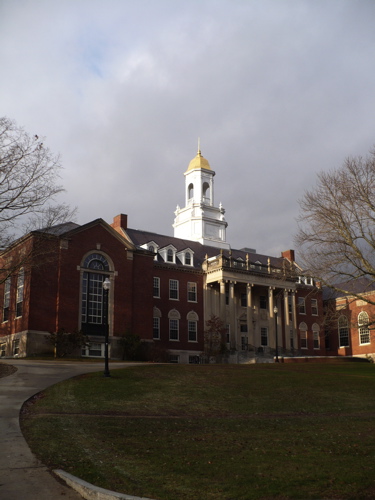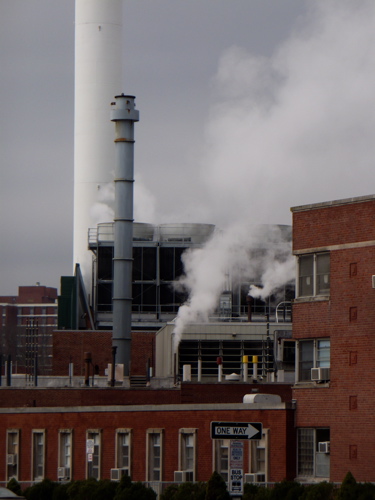If the campus has a certain relationship with the land, does it also have a relationship to the sky? Does academic space have an upper boundary or a top? Or does it stretch up into the academo-stratosphere (as my friend Jess Falcone puts it) or eventually out into the void where academic “stars” shine?
One of the ways universities organize their peaks is with built objects that rise higher than others, that rise for the sake of rising, because height is symbolically potent: a church, a gilded library cupola, a smokestack, a triplet of water towers, a triplet of flagpoles.
Two opposed types of structures reach skyward on this campus (again the University of Connecticut): the most ritualized and symbolic rise beside the most utilitarian and nameless. On one hand, the steeple of the Storrs Congregational Church, the flags of Connecticut and the U.S.A. and the university, and the cupola of the Wilbur Cross Library. On the other hand, the radio tower, the water towers and the smokestacks. The sky simultaneously represents the heights towards which the most sacred buildings reach, and the dumping ground for the exhaust from the campus heating plant. The university as factory collides with the university as temple. (Of course, the more utilitarian, industrial towers and smokestacks are far taller than the merely symbolically tall flags and cupolas – twice as high, at least. But this physical fact may not be very symbolically significant.)
According to Mary LeCron Foster, a symbolic anthropologist writing before I was born, the line and what she calls “lineality” are key cultural symbols of white America, and “up” the preferred cultural direction:
Our skyscrapers, jet planes, and spaceships all attest to the fact that the preferred line is up. We move “up” in our professions or “go to the top” of the class or the organization. It seems no accident that we are “up” from the ape since this is construed as progress, nor that history moves “down” to the present if no particular progress is implied. To the extent that we are future oriented we are also ahistorical, tending to forget events that happened earlier than yesterday. As “up” is good so “down” is bad. To be “down” is to be “out.” “Low” character contrasts with “high” moral worth.
Universities are indeed “up,” or at least are at the top of a number of our prestige hierarchies: they’re reckoned more advanced than secondary or primary education, more pure than technical schools, more comprehensive than colleges, more free in their intellectual inquiry and critical reach than other fora – one could go on with these cultural associations (not that I endorse them), or perhaps just note that it is, after all, called “higher” education.
Yet oddly enough, the campus buildings that most reach skyward, in their architecture, are the most traditional: the church and the library. The physically largest academic buildings, on the other hand, do tend to be the most futuristic, and the most recently built: the vast laboratories built for the sciences and engineering schools, the business school, the sports stadium. But although these modern buildings may be tall, they seldom face up.
To find a modern structure that symbolically appeals to the sky we have to look elsewhere: to the blue emergency phone, built in a little tower, capped with a little cupola of its own, reminiscent of a police siren. It appears to be at once sacred and utterly pragmatic: it promises immediate police assistance while serving as a symbol of protection against the forces of chaos, criminality, threat, fear, rape, robbery, drunken mayhem, and other evils that spread across the campus grounds, especially at night. Its color, blue, symbolizes the police, but the sky too, as if the emergency phone offered rescue “out of the blue,” from above.





